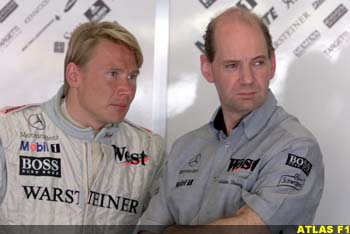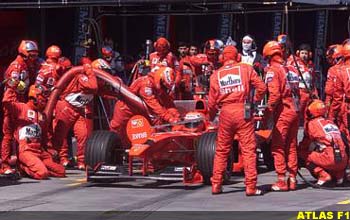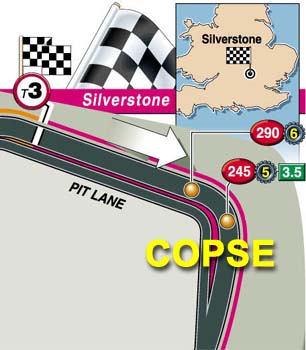|
| |||
 |
Taking the Lid Off F1 Formula One Technical Analysis | ||
| by Will Gray, England | |||
|
Atlas F1 presents a series of articles by certified engineer Will Gray, that investigates in greater depth all the technical areas involved in design, development, and construction of a Formula One car.
Speed depends on the dynamics of the car - or how smoothly and efficiently it can weave its way around the set of corners we call the race-track. In driving the car, the Damon Hills and Michael Schumachers of this world must use the car to its limits. In designing it, the talents of Adrian Newey and the like are are used to make that car the best. But what is the best - what do we want from a race-car?
But there are many of factors which determine that all important '0-100' time. The weight is a major factor - a light car has less weight to move, so will accelerate faster. With F1 rules, the weight limit is such that most teams need to use ballast to meet the minimum weight. That makes fuel strategy even more important - an empty tank makes a car much lighter than one on full fuel, so making two or three stops affects the weight of the car, thus the acceleration, and therefore the eventual lap time achieved.
A car at any weight, however, will need an engine with good low-end power to accelerate quickly and some good rubber to get the power down fast. Braking is a method of taking off speed by converting the kinetic, or movement, energy into heat in the brakes and tyres. Top speed is again determined by the factors above, but the main factor which separates the victors from the valiants in this area is the aerodynamic performance - too much drag and you're pulling unwanted air along with you. It is in efficiency where the skills of the aerodynamicist are tested to the full. He must obtain as much downforce as he can without creating too much drag, and slowing the car. Drag, along with engine performance, can lead to some dramatically different top speeds between the leading teams and those towards the back. However, it is important to note that top speed is important to have, but it's generally more important to get around the corners fast. It is here that the most important Formula One trade-off takes place. Forget all others, this is F1 in a nutshell - Fast or Nimble? To go forward fast, you must aim to minimise drag. To corner fast, you must maximise downforce (to maximise the grip on the racetrack). Unfortunately, downforce comes at a price - the price of additional drag! Cars can be lightening on the straight, yet be a second down on lap time. Why? The engineers haven't balanced the level of downforce and straight line speed required. Cornering is critical. A car will have to decrease its speed to go from a straight, around a corner, and onto another straight. The ability to go around this quickest is paramount in a successful car. A decrease in speed must be re-claimed once back on the straight, so the car which loses the least speed will have to accelerate the least when back on the straight - and accelerating takes time.
This is the point through which the weight of the car is seen to act, or the point where the car would balance on a pivot - you can find the centre of gravity of, say, a fork, by where your finger is when the fork balances level. Designers want the centre of gravity in a race car low to the floor. Other major criterion in cornering are the design of the suspension and tyres, the load transfer characteristics, and the downforce on the car. All the above discussions are coupled together, and fit under the banner of 'Driveability'. The designer strives for this, and it must be the biggest dagger a driver places in the designer's heart when he claims the car is 'undriveable'! Along with all those factors described previously, the relationship between the centre of gravity and the aerodynamic centre is crucial for a driver's confidence. The aerodynamic centre is similar to the centre of gravity in definition. It is the point through which the force created by the aerodynamics is seen to act. The fuel, which is the only part of the car to change weight significantly during the race, is positioned in such that the centre of gravity doesn't move significantly. However, the aerodynamic force is constantly changing, so keeping the aerodynamic centre in the same place throughout a lap is a near impossible task. As the car is so close to the ground, millimetres of ride height (distance between the car and the ground) change downforce levels significantly. If the front is closer to the ground than the rear (as in braking), there will be more downforce on the front than normal, and the aerodynamic centre will move forward. In contrast, accelerating lifts up the front, and the aero centre moves back. To the driver, this movement feels unsettling, so the more level the car can be through accelerating, braking, cornering, and over the bumps, the more controllable it will be. For that reason, suspension stiffness is also important, as are load transfer characteristics. The complexities of compromises between all of these factors make the difference between the car being fast, and the team being furious!
|
| Will Gray | © 1999 Kaizar.Com, Incorporated. |
| Send comments to: gray@atlasf1.com | Terms & Conditions |


 The design of this corner will, to a point, limit the car's speed around it. The other factor is the cornering ability of the car. To take a corner like Copse at Silverstone in a Formula Ford car would be very different to doing it in an F1 machine due to the difference in design between the two vehicles. Even taking it in two different Formula One cars would have different effects. The competence of a car in cornering comes in part from the height of the centre of gravity.
The design of this corner will, to a point, limit the car's speed around it. The other factor is the cornering ability of the car. To take a corner like Copse at Silverstone in a Formula Ford car would be very different to doing it in an F1 machine due to the difference in design between the two vehicles. Even taking it in two different Formula One cars would have different effects. The competence of a car in cornering comes in part from the height of the centre of gravity.